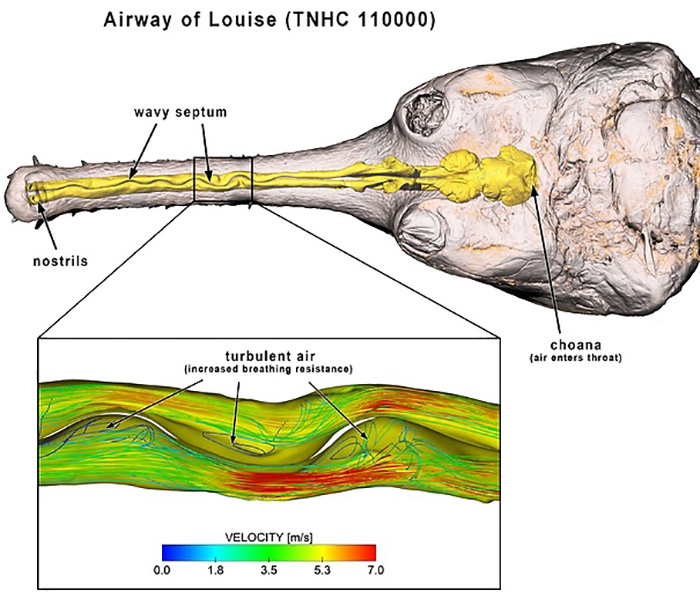Research published in the journal Anatomical Record finds that humans have more in common with endangered crocodiles than we think—namely, a deviated septum.

Credit: Jason Bourke, Ph.D.
Research published in the journal Anatomical Record finds that humans have more in common with endangered crocodiles than we think—namely, a deviated septum.
Gharials are some of the rarest crocodylians on Earth and members of a group of animals that once roamed the planet with the dinosaurs. Native to India, gharials resemble American alligators and crocodiles, but with bulging eyes and an extremely long and thin snout that allows them to cut through water when hunting prey. In males, this snout houses an even longer nose that ends in an enlarged bulb.
At first glance, these unusual animals appear to have little in common with humans. However, a new study led by Jason Bourke, Ph.D., assistant professor of basic sciences at the College of Osteopathic Medicine at Arkansas State University (NYITCOM-Arkansas), reports that—just like humans—gharials suffer from nasal septal deviation.
The Cleveland Clinic estimates that up to 80 percent of people have a deviated septum, a condition in which the nasal cartilage is “off-center.” While the condition is mild in most individuals, larger deviations can restrict nasal breathing and require reconstructive surgery.
Bourke and his colleagues are the first to document deviated nasal septa in crocodylians. Using medical imaging technology, they analyzed the heads of multiple gharial specimens, including that of a large female from the Fort Worth Zoo nicknamed “Louise,” which fueled their curiosity.
“This weird nasal septum was an unexpected discovery,” said study co-author Casey Holliday, Ph.D., associate professor of pathology and anatomical sciences at the University of Missouri, who initially scanned the specimen for a separate project on gharial anatomy. “I saw this roller coaster of a septum and wondered what this might mean for respiration.”
Holliday shared Louise’s extreme anatomy with Bourke, a vertebrate paleontologist whose lab specializes in modeling fluid dynamics in animal noses using sophisticated computer software that simulates air movement.
“We know remarkably little about normal gharial anatomy, much less their pathology. I couldn’t pass up such a unique opportunity,” said Bourke, who has also studied nasal airflow and thermoregulation in dinosaurs.
Intrigued, Bourke and the team began collecting samples from other gharial specimens housed in zoos around the country. While some specimens showed minor septal deviations, Louise had the most extreme case.
Like humans who experience severe nasal septum deviation, Louise had to work harder to achieve the same breathing rate as her peers. This produced high shearing stresses along the nasal walls, which may have made the animal more prone to nosebleeds. Despite the physiological challenges produced from this nasal pathology, Louise successfully made it to adulthood and lived to the ripe old age of 50.
“It’s a testament to crocodylian resiliency,” said Bourke. “A human with this pathology would need surgery to fix it, but these critters just keep on going.”
In contrast to humans, the researchers found that gharial septal deviation comes with a unique twist. “When the septum deviates in humans, a part or all of the septum bows into one of the airways,” said Nicole Fontenot, fourth-year NYITCOM student, and study co-author. “In our gharials, the septum is so long that it wiggles back and forth along the snout, creating a wavy pattern.”
While this pathology is not found in other modern crocodylians, in the distant past, many other animals showed similarly stretched-out noses, including crested, duck-billed dinosaurs like Parasaurolophus and strange crocodile-mimicking reptiles known as champsosaurs. Bourke suspects that at least a few of them would have also suffered from nasal septum deviations. As for why other crocodylians don’t seem to be as prone to these deviated noses, Bourke explains:
“Other crocodylians have wider snouts with much thicker nasal septa. Thinning out the snout places a premium on space inside the nose. Gharials’ long and very thin nasal septa probably don’t need much to make them start wobbling.
Next, the researchers will continue their investigation by examining the sound-producing abilities of gharials’ unique noses.
About New York Institute of Technology
New York Institute of Technology’s six schools and colleges offer undergraduate, graduate, and professional degree programs in in-demand disciplines including computer science, data science, and cybersecurity; biology, health professions, and medicine; architecture and design; engineering; IT and digital technologies; management; and energy and sustainability. A nonprofit, independent, private, and nonsectarian institute of higher education founded in 1955, it welcomes nearly 8,000 students worldwide. The university has campuses in New York City and Long Island, New York; Jonesboro, Arkansas; and Vancouver, British Columbia, as well as programs around the world. Nearly 110,000 alumni are part of an engaged network of physicians, architects, scientists, engineers, business leaders, digital artists, and healthcare professionals. Together, the university’s community of doers, makers, healers, and innovators empowers graduates to change the world, solve 21st-century challenges, and reinvent the future.
Journal
The Anatomical Record
DOI
10.1002/ar.24831
Method of Research
Computational simulation/modeling
Subject of Research
Animals
Article Title
Septal deviation in the nose of the longest faced crocodylian: A description of nasal anatomy and airflow in the Indian gharial (Gavialis gangeticus) with comments on acoustics
Article Publication Date
23-Nov-2021




